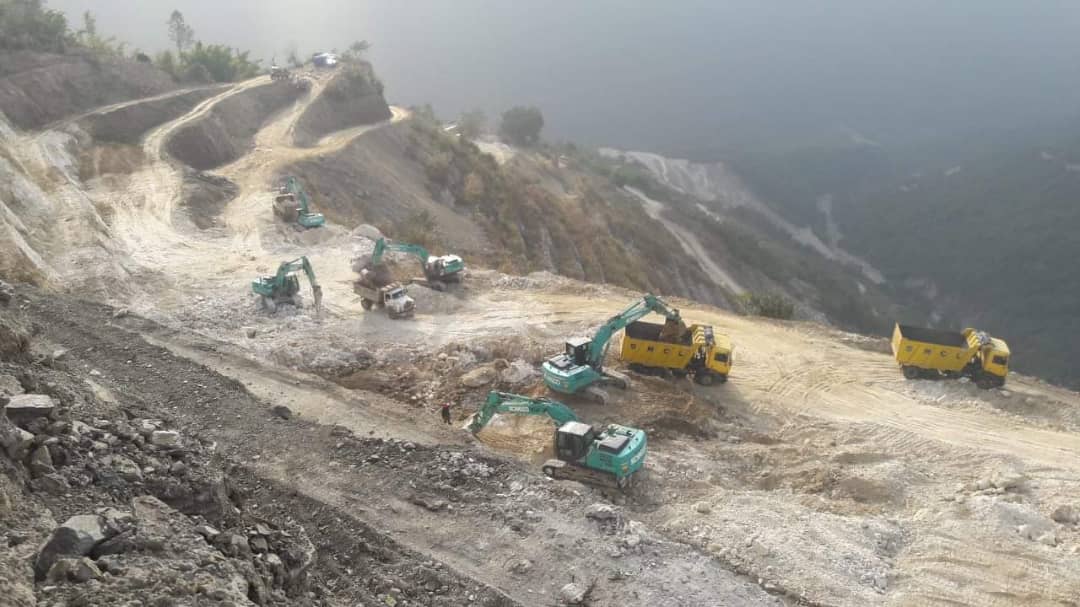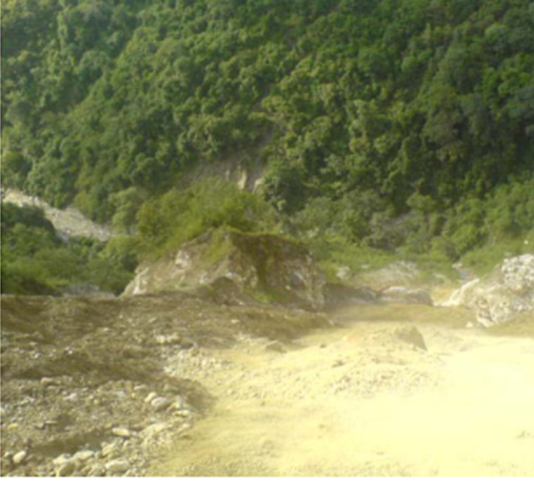Bringing Community Together and Empowering to Understand Potential Impacts of Gypsum Mining on Health, Water Resources and Air; Compromising Their Lives and Livelihood.
 |
Earth Guardians of Bhutan | |
 |
Chandra Man Rai | |
 |
||
 |
US$4,000 |
Research Background Final Report (abstract) Others

Open mine caste at Khothagpa.

Waste and debris entering the stream .
Research Background
Bhutan's rapid pace of development and economic transformation have threatened both natural resources and society significantly due to lack of robust monitoring and investigation of potential risks. One of the high risk imposed economic activities on society in Bhutan is mining. Due to improper planning and negligence of regulations, mining operation has resulted in irreplaceable damage, degradation, and deterioration to the environment; disturbances to water, air, and soil ecosystem; and ultimately brought about a wide range of costs to the society.
The current 12th Five Year Plan of Government of Bhutan prioritize mining as the main source of the nation's economy. There are several approved mining projects that have commenced already and some are on the pipelines. Though the plan has been a controversial issue among environmentalist, conservationist, and youth pursuing citizen science there is a major lack of support from the government. Moreover, most of the projects established are in far-flung places where the majority of community people are illiterate, farmers, and marginalized groups. This has led to a lack of understanding about potential impacts, operations, and possible health risk of mining to the inhabitant of the area.
One of the established Gypsum mining projects is located in Khothagpa Village under Pema Gatshel district in the eastern part of the country. There are more than a hundred households in the village. The operation of the Gypsum mining project has hugely impacted on their livelihood and daily activities by destructing forest resources, polluting the water and air and deteriorating agricultural production, accelerating the geological related catastrophes such as landslides and safety problems caused from the speeding vehicular transportations.
Therefore, the proposed project aims to 1) create public awareness about health risks and environmental impacts of mining encouraging public participation, 2) Involve all the stakeholders including local leader, conservationists, and mining company to collaboratively work to make environment sound and safe to live, 3) Focus particularly on mining company to be responsible for the socio-environmental impacts and help the local community to solve the problems.
The project will assess the water quality of nearby rivers and streams. The air quality will be also assessed and probable respiratory and other cases of air-borne diseases will be collected from the hospital. Our priority in this project is to involve all the people of the community in the research using and educate them on socio-environmental risks of mining projects. The study will use Participatory Rural Appraisal (PRA) tools, Semi-structured Questionnaire and Interviews, and Focused Group Discussion to collect the data.
[Sep. 2019]
Final Report (abstract)
The first half of the project was carried out from January through June, 2020. In the early months of the project, questionnaire was developed, revised, and consulted with the local communities and local authorities. The logistic preparation including printing of necessary documents, seeking of permission, and equipment arrangement was conducted. For this, all of the relevant stakeholders and research teams were involved. The later phase of the project focused on communication of the findings to the local communities, Mining Company, and the government.
Following month, data was collected from the hundreds of household that was located in the vicinity of the mining area where distance between the house and mining site ranges from 100 meters to one to two kilometers. This radius of distance was considered as a core zone for data collection assuming the most affected communities from the activities of mining operation resides within this zone.
The data was collected primarily on three aspects; social, economic, and environmental, taking an account of both positive and negative impacts of mining. The study found that the negative impacts out weighted the positive impacts indicating that respondents expressed more negative impacts of mining at the local level. For instance, a majority (>90%) of the respondents noted that mining has been a major detriment to their agriculture due to emulsification of dusts on the leaves of the crops reducing the production and then ultimate killing of the crops. The dust has also made fodder for livestock inconsumable deteriorating the whole fodder system and transforming pasture land into dump yard. About 90% of the local people also complained about the release of vehicle exhaust and debris from the mining area polluting the water stream which directly drains into the main river.
Due to traffic congestion aggravated by high speed trucks risked the lives of student and commuters in the roads. Majority of the respondents (> 80%) shared that roads are dusty during dry and muddy during monsoon season which become impossible to commute. Though there is no plausible data to substantiate the disease outbreak due to the dust or release of other pollutants, residents still share common grievances about occasional cough and cold aggravated by dust. Noise pollution and vibration from blasting and cracking of the rocks is the most nuisance within the proximity of one kilometer.
On the environmental account, a high amount of release of dusts have polluted land, water, air, and biodiversity. Majority of the respondents (>70%) asserted that a large number of excavators during working hours and large ferrying of trucks, at times, make area full of dusts and particulate matters releasing into the air decreasing the visibility of clear atmosphere. Not only this, the plants and trees have also been affected with high patches of dusts on leaves. Several residents had experienced a sudden loss of wild animals around the vicinity of the mining area.
The cascading wastes such as debris entering into the streams have polluted the water. The water quality of streams collected from the three zones show that the middle zone and lower zone, which are the most affected zones show high concentration of pollutants revealed by the physical properties of water.
However, due to mining company being close to the village, they are also able to sell whatever is produced from the affected crops to the mining workers. There were about seven shops around the vicinity of the mining area, benefitting from mine workers being their main customers. Employment was another positive impact where husband of the family is employed either through trucking or site supervision. These positive aspects of mining has been regarded as an opportunity for the benefited localities for improved livelihoods and change in lifestyle. However, impact is considered as a meager portion in comparison to negative impacts.
The findings of the research was presented to the villagers and the officials of the company through sensitization, education, and awareness program. The data is also shared with National Environment Commission of Bhutan, the highest level decision making body on the environment in the country.
[Dec. 2020]
Others
